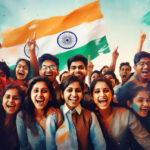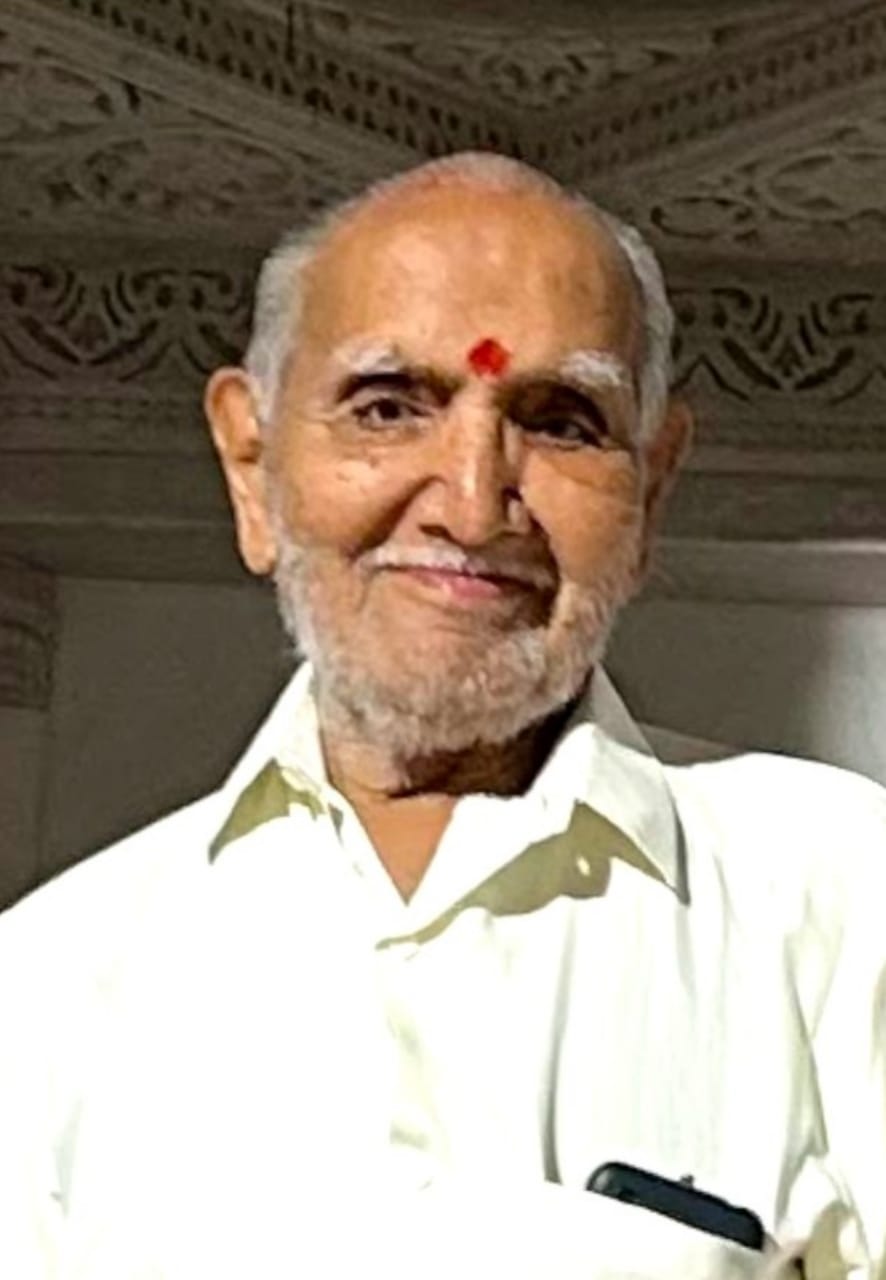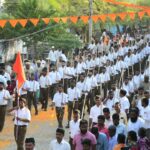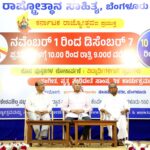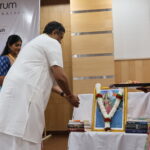
Ram Madhav, RSS senior functionary
article by Ram Madhav, RSS senior functionary March 27, 2014

Varshney’s Hindu Nationalists are True Universalists & Humanists
Dr. Ashutosh Varshney, like many of his colleagues is a known professor of distortion. In his latest article ‘Modi the Moderate’, published by the Indian Express on March 27, 2014, Varshney amply demonstrates his skill once again.
“Anyone who has read the basic works of Hindu Nationalism knows that three ideas constitute the thematic core of Hindu nationalist ideology”, he claims. As the ‘basic works’ he cites V.D. Savarkar’s Hindutva. The ‘three ideas’, according to him, are – First, Hindus are the primary, or exclusive, owners of the Indian nation. India is a Hindu rashtra (nation). Second, two minorities – the Christians and especially the Muslims – have a profound ambivalent relationship with India. Third, caste divisions within Hinduism and caste-based politics need to be minimized, for they undermine Hindu unity. The lower castes should follow the Brahminical model of Hinduism.
Varshney’s intentional bias, as against genuine scholarship, is glaring in every sentence of his write up. For, a true scholar looks at the entire gamut of literature before jumping to any conclusion on any subject. But past masters in academic deception take statements out of context, quote them partially, twist them to suit their biased arguments and deliberately ignore all the other available material. Varshney had done no better.
Let us look at the first distortion about Hindu Rashtra. Hinduness as a cultural identity that this ancient nation has come to acquire is what Hindu nationalists have always propagated. In this proposition, Hindu doesn’t come to represent any religion or mode of worship. Instead, it is a set of values that have come to be known as the Sanatana Dharma. Savarkar himself had given a clear definition to the word Hindu in his book ‘Hindutva’ thus:
Aasindhu sindhu paryantaa Yasya Bharata Bhoomika
Pitrubhu Punyabhuchaiva Tavai Hinduriti Smritah
‘Those who regard this land of Bharat spread between river Sindhu (in the north) to the ocean Sindhu (Sindhu Sagar – Indian Ocean in the south) as their Pitrubhumi – Fatherland and Punyabhumi – Holy land are called as Hindus’.
It is more about emotional bonding with the country in which they were born. But Savarkar never differentiated Hindus and Muslims as superior and inferior.In the manifesto of ‘Hindu Rashtra’, which Varshney had referred to as the basic text, Savarkar states: “Religious minorities will have all the right to practice their religion in a Hindu Rashtra and the State will ensure that; but the Hindu Rashra won’t allow creation of a nation within a nation in the name of religious minoritysm.” What’s wrong with it? This is exactly the situation in the country where Varshney has grown up and prospered, the USA.
Infact, Shri M.S. Golwalkar ‘Guruji’ told an Iranian scholar by name Saifuddin Jeelani in 1971 that: “According to our ways of religious belief and philosophy, a Muslim is as good as a Hindu. It is not the Hindu alone who will reach the ultimate Godhead. Everyone has the right to follow his path according to his own persuasion. That is our attitude.”
Talking to some media persons in 1970, he made a categorical statement that: “So far as the work for the country is concerned, I do not distinguish between Hindus and Muslims”. To a question as to what he meant by ‘Muslims joining the mainstream’, Shri Golwalkar replied: “They should experience the same ‘sense of belonging’, as the Hindus do, to this country, its people, its culture, tradition and history and also its past memories and future aspirations. If, after fulfilling all these, anybody says that he has studied the Koran or the Bible and that way of worship strikes a sympathetic chord in his heart, he is welcome to follow it. Thus he has his choice in a portion of his individual life. For the rest, he must be one with the national current.
We have been in existence as a nation for scores of centuries. There are some fundamentals on which our national life is resting. That is our mainstream. We want all people to come to the mainstream of national life but not to lose their identity”.
Where is the question of primacy or exclusivity? If a pre-Islamic Persian hero like Rustom can still be admired by the Muslims, why not the pre-Islamic heroes in India be respected similarly? Many Hindus do not believe in God, Reincarnation etc. Yet they respect the heroes of ancient India as cultural heroes.
But Varshney has objection to Savarkar asking non-Hindus to regard this country as Punyabhumi – Holy land. He insinuates that Savarkar had said of Christians and Muslims that “India is not their Punyabhumi (Holy land)”. “As a result their love for India is divided. They need to demonstrate their fidelity to India, or must be made Indians; Indian loyalties cannot be assumed to exist”, is how Varshney interprets Savarkar’s view.
Firstly, one fails to understand what objections one can have with regard to asking people to have “undivided” loyalty to their ‘motherland’ or ‘fatherland’. But Varshney’s objection seems to be about the other part, “Indian loyalties cannot be assumed to exist”.
Before taking up this insinuation, it is important to note that Savarkar had always maintained that he didn’t differentiate between Hindus and Muslims.When a journalist asked him in Lahore in 1938, when he was Hindu Mahasabha President, as to why he and Jinnah were bent upon dividing the nation along communal lines, his reply was sharp: “Your question is misplaced. While I am for equal treatment for all, Jinnah is for more and more concessions for Muslims”. This emphatically exposes the hollowness of the charges that Savarkar wanted Muslims as second class citizens in a Hindu Rashtra, which people like Varshney want to falsely propagate.
Here it is also important to understand the context – the prevailing situation in India at that time. Large sections of Muslim population were influenced by Jinnah’s Two Nation theory causing serious consternation in the minds of many a leader of those times. Forget about what leaders like Sardar Patel had said, even a leader like Pt. Jawaharlal Nehru, the darling to Varshney and his ilk, had raised a voice of concern about the loyalty of the Muslims that remained in India.
“I have said that I am proud of our inheritance and our ancestors who gave an intellectual and cultural pre-eminence to India. How do you feel about this past? Do you feel that you are also sharers in it and inheritors of it and, therefore, proud of something that belongs to you as much as to me? Or do you feel alien to it and pass it by without understanding it or feeling that strange thrill which comes from the realisation that we are the trustees and inheritors of this vast treasure? I ask you these questions, because in recent years many forces have been at play diverting people’s minds into wrong channels and trying to pervert the course of history. You are Muslims and I am a Hindu. We may adhere to different religious faiths or even to none; but that does not take away from us that cultural inheritance that is yours as well as mine”
– This is what Nehru asked the students of Aligarh Muslim University in 1948. How is it different from what Savarkar had said at that time?
Let me quote another senior leader of those times on this issue.
“Islam is a close corporation and the distinction that it makes between Muslims and non-Muslims is a very real, very positive and very alienating distinction. The brotherhood of Islam is not the universal brotherhood of man. It is brotherhood of Muslims for Muslims only. There is a fraternity but its benefit is confined to those within that corporation. For those who are outside the corporation, there is nothing but contempt and enmity” – This was not Savarkar or Golwalkar. This was Ambedkar in his book “Pakistan or The Partition of India”.
Ambedkar also makes the same point that Varshney objects to in Savarkar’s arguments, namely their loyalty. “Islam is a system of social self-government and is incompatible with local self-government, because the allegiance of a Muslim does not rest on his domicile in the country which is his but on the faith to which he belongs. To the Muslim, wherever there is the rule of Islam, there is his own country. In other words, Islam can never allow a true Muslim to adopt India as his motherland and regard a Hindu as his kith and kin”, he says.
Savarkar, and for that matter Golwalkar believed in and worked for Hindu-Muslim unity. Their approach was different from that practised by others at that time. But their commitment to it was above-board. In early 1940s Savarkar openly appreciated when a Group of Muslims in Lucknow in appreciation of the efforts being made by Congress for Hindu-Muslim unity got together and passed a resolution saying ‘any Muslim slaughtering a cow will be considered an enemy of Hindu-Muslim unity’. Savarkar immediately issued a press statement appreciating this gesture on the part of Lucknow Muslims and said “if such gestures keep on coming from Muslims Hindu-Muslim unity is possible”.
Unlike Savarkar and Golwalkar who believed that Hindu – Muslim unity is possible through genuine reform, Ambedkar was categorical that it was a near impossibility. “… a great gulf has remained fixed between the two and their enforced political union either under the Moghuls or the British ….has only accentuated their mutual antipathy. Neither religion nor social code can bridge this gulf. The two faiths are mutually exclusive and whatever harmonies may be forged in the interest of good social behaviour, at their core and centre they are irreconcilable”, concludes Ambedkar. I hope Varshney wouldn’t call Ambedkar a Hindu supremacist. However, even these statements of Ambedkar shouldn’t be taken out of context to suggest that he was anti-Muslim. The primary concern of all the national leaders at that time was to somehow ensure national unity by understanding and exploring socio-religious dynamics.
That brings us to the third point about caste and Hinduism. Here again, Varshney uses his sleight to distort the argument because of his inherent bias. Hindutva’s emphasis on minimising caste distinctions and creating Hindu unity is interpreted by him as forcing lower castes to follow ‘Brahminical model of Hinduism’. As is the standard practise, Varshney doesn’t explain as to what was that ‘Brahminical model of Hinduism’. He knew that both Savarkar and Golwalkar were opposed to hierarchical system of caste superiority which has come to be identified with the word ‘Brahminical’.
All his life, Savarkar fought against caste-based inequalities and untouchability. He was the first to launch temple entry campaign for Harijans. He was unequivocal in his condemnation of the distorted caste system. “As the Sanatana Dharma did not die due to this tectonic change, so too it will not die if the present-day distortion that is caste division is destroyed”, he exhorted.
Infact, Varshney’s Hindu nationalist is at core not an exclusivist, but a universalist and humanist. Rejecting the Notions of ‘high and low’ on basis of the caste by birth, Savarkar wrote: “No one should ever think that a certain Hindu caste is high or that another is low. The notion of high and low will be determined by overt merit of individuals. Every Hindu child has but one caste at birth- Hindu. Other than that, consider no other sub-caste. ‘Janmanaa jaayate Hinduhu’ (‘every one is a Hindu by birth’)! In truth, every man has but one caste at birth- human. But at least so long as other religionists such as Muslims and Christians keep aside that lofty aim and consider themselves Muslims and Christians by birth and endeavor to swallow the Hindu, we too must cling to the identity of our race. On every occasion and especially during census, register yourselves as Hindus only. Consider all castes as occupations.
The Hindu nationalist whom Varshney called ‘Brahminical’ declared once that “I felt like rebelling against the caste system. Just as I felt I should rebel against the foreign rule over Hindusthan, I also felt that I should rebel against the caste system and untouchability in Hindusthan.”
Problem with scholars like Varshney is that they write conclusions first and then the hypothesis. Their biases become their arguments and their positions the launching pad for their false rhetoric.
Fortunately for us, the average Indian turned out to be more scholarly and understanding, and capable of chafing truth from hyperbole.

